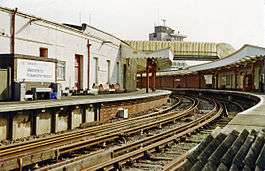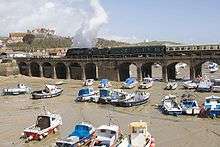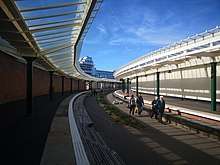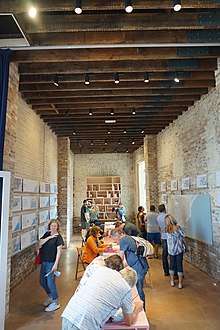Folkestone Harbour railway station
Folkestone Harbour station was built to serve the port of Folkestone in Kent, one of four railway stations in the town. It was at the end of the short 1-in-30 Folkestone Harbour Branch Line which joined the South Eastern Main Line at Folkestone Junction. The branch and harbour station were provided for boat trains from London which connected with the ferry services to Calais and Boulogne.
| Folkestone Harbour | |
|---|---|
 Tracks running into the station | |
| Location | |
| Place | Folkestone |
| Area | Folkestone & Hythe |
| Operations | |
| Platforms | 2 (latterly 1) |
| History | |
| 1 January 1849 | First station opened |
| 1856 | Station resited |
| 29 November 1915 | Temporary closure |
| 1 March 1919 | Reopened |
| 4 September 1939 | Temporary closure |
| 1945 | Reopened |
| 2001 | Station closed to regular traffic |
| 2009 | Line closed to all traffic |
| 2014 | Line officially closed |
| Disused railway stations in the United Kingdom | |
| Closed railway stations in Britain A B C D–F G H–J K–L M–O P–R S T–V W–Z | |
The branch and station closed to regular passenger train services in 2001 although they were used by the Venice-Simplon Orient Express (VSOE) and railtours until 2009. An occasional inspection train used the line until the it was officially closed on 31 May 2014.
History
19th century

Folkestone Harbour was in decline in the 1830s, as nearby Dover became an increasingly important cross-channel port. Ships had difficulty approaching because of drifting shingle blocking the entryway. The harbour was acquired by the South Eastern Railway (SER) in August 1843 for redevelopment, but the steep chalk downs around the town made it impractical to route a main railway line through it. Consequently, a branch line was proposed.[1]
Construction began in 1843, with the line intended mainly for freight.[2][3] The route left the main line at Folkestone Junction and was double tracked, running at a gradient of 1 in 32.[1] It reached the harbour on a 138-foot (42 m) viaduct designed by SER chief engineer William Cubitt. A swing bridge was added to the viaduct in 1847, which allowed trains to cross the harbour and reach the southern pier.[3][4]
For most of its life, the station's main traffic was passengers travelling on boat trains direct to London, albeit with a change of direction (reversal) at Folkestone East.[5] The SER planned to extend the branch line from Sandling to Sandgate to reach the harbour directly, but were blocked by the Earl of Radnor who owned the land.[6]
The line was passed by the Board of Trade for passenger use in 1848.[7] The station was opened on 1 January 1849, but was replaced by another on a different site in 1856. This second station went through periods of temporary closure: from 29 November 1915 until 1 March 1919; from 4 September 1939 until 1945; from 13 to 20 March 1960; and between 1 January and 11 April 1992.[8]
The station was frequently used during World War I, where soldiers would disembark for a ship to Flanders.[4]
A three-track wide goods shed was added to the station in 1881. It moved in 1899 and 1910, before closing in 1919. It continued to be used for rail purposes until it was demolished in the early 1960s.[9]
The swing bridge over the harbour was replaced in 1893. The current bridge was constructed by the Southern Railway in 1930, designed by the company's chief engineer George Ellson.[4]
20th - 21st century
The line was electrified at the same time as the main line during the "Kent Coast Electrification – Stage 2" in June 1961, and passenger trains were formed of electric multiple units. Freight services were withdrawn on 17 August 1968.[10]
In 1994, the opening of the Channel Tunnel led to the majority of ferry operators moving to other ports in the South East, with the result that only two services per day were arriving at Folkestone Harbour, to connect with the Hoverspeed SeaCat services. When these were moved to Ramsgate, the station closed to ordinary rail traffic in 2001.[2]
Sometime after 2001, the line was singled for operational purposes, although the disused line is still in position.
The swing bridge over the harbour was Grade II listed in January 2012.[4]
Services
Until 2009, Venice Simplon Orient Express operated two scheduled services per week to Folkestone Harbour on its London to Paris route,[11] which ran on Thursday and Sunday between March and November when the British Pullman service terminated there. Passengers were transferred by coach to the Eurotunnel terminal, where they joined a Eurotunnel Shuttle to Calais to pick up the Orient Express in France.
_on_the_climb_from_Folkestone_Harbour_(24_January_2009).jpg)
Closure
Plans to regenerate Folkestone Harbour included 1,000 new houses and apartments, but they could not be practically served by the branch line. Network Rail decided that it could not justify spending considerable amounts of money to maintain and upgrade the route, so it began the process to close the station permanently. The viaduct would be retained as a new pedestrian route.[12] A closure ceremony with an official last train took place on 12 April 2008.[13]
The closure was objected by DB Schenker, the Department for Transport and Southeastern. During 2008, the Venice-Simplon Orient Express still used Folkestone Harbour with its last train travelling on 13 November,[14] and a number of rail tours visited the branch. Advertised as the last train, a steam hauled rail tour visited the branch on 14 March 2009.[15]
Reliant on closure of the line, a proposed Folkestone Harbour and Seafront Masterplan included plans to demolish the viaduct to make way for a new marina.[16] An association opposing the closure was formed, with the primary aim of gaining control of the branch either through purchase or a lease with an option to buy.[16] The group, called the Remembrance Line Association proposes turning it into a mainline connected heritage railway, a 'Leaving for War' museum and a memorial dedicated to the troops that arrived on trains to the branch and left on ships to fight in both World War I and World War II.[16] It also proposes hosting regular national railtours to the branch, and would permanently operate a tourist shuttle service up and down the 1in30 gradient, utilising its own rolling stock and locomotives. Further plans include a revived passenger ferry to Boulogne. On 21 December 2008, the Remembrance Line Association ran a railtour to the branch using the Southern Railway preserved diesel electric Class 201 No. 1001.[17]
On 20 March 2009, Network Rail announced they had begun the formal process to close the line and station on cost grounds, having redeveloped Folkestone West with new waiting facilities for the VSOE passengers. However, up to August 2010, the closure process had not proceeded past the statutory 'mothballing' stage, making the railway still officially operational. This was to allow protracted negotiations between all interested parties to run their full course to ensure the optimum benefits for the Folkestone Harbour statutory port area and to fully investigate heritage, conservation and other planning issues pertaining to the Shepway District as a whole.[18]
On 20 November 2013 the Department for Transport published a proposal to close the line and station serving Folkestone Harbour. Consultation on the closure ended on 28 February 2014,[19] and the line was formally closed on 31 May 2014.[20][21]
Restoration


In 2015, the Folkestone Harbour Company commenced a £3.5 million project to refurbish the viaduct and the station, retaining the remaining tracks, and repairing the canopies and the Customs House.[11] The viaduct across the harbour was opened as a pedestrian route to the station in September 2017.
The restoration of the station has included the installation of bilingual signage and platform lighting for platforms 1 and 2 based on 1950s evidence, and the beige and green colour scheme for the walls, columns and canopies originally used by South Eastern Railway around 1900.
The imposing Folkestone Harbour Station Customs House, built in 1856, was destroyed by bombing in WWII, but the luggage tagging room survived. This room has been restored and was reopened in 2017, and has hosted exhibitions i.e. the Urban Room from the Folkestone Triennnial.[22]
A number of box cars are being installed on the tracks, and several original Pullman carriages built for the London – Folkestone route have been purchased and are currently in the process of renovation, to be installed in the station in 2019. Several artworks from the Folkestone Triennial 2011, 2014 and 2017 are installed in the station. These include the Rug People by Varga Weisz[23] and the large Folkestone sign by Patrick Tiuttofuoco[24]
In the future, Folkestone Harbour station will become integrated into the wider development of the beachfront and the harbour, with restaurants, workshops, galleries and nightclubs to be built alongside the station platforms.[25]
Incidents
On 19 March 1844, a platelayer was killed on the incline leading into the station when he was hit by a coal train without brakes.[26]
References
Citations
- Gray 1990, p. 259.
- McCarthy & McCarthy 2007, p. 52.
- Gray 1990, p. 261.
- Historic England. "Details from listed building database (1404114)". National Heritage List for England. Retrieved 28 March 2020.
- McCarthy & McCarthy 2007, Map sixteen.
- Gray 1990, p. 150.
- "Folkestone Harbour Station". Ruthparkinson.co.uk. Retrieved 1 December 2013.
- Butt 1995, p. 98.
- McCarthy & McCarthy 2007, p. 72.
- "Kent Rail Folkestone Harbour". Kentrail.org.uk. 12 April 2008. Retrieved 1 December 2013.
- "Inside the derelict Folkestone railway line as Network Rail plan transformations". Kent Live. 23 January 2019. Retrieved 31 March 2020.
- "Folkestone Harbour Masterplan" (PDF). Folkestone Harbour. Archived from the original (PDF) on 6 November 2006.
- Railway Herald Issue 127
- Railway Herald Issue 155
- Railway Herald Issue 170
- Steam Railway Magazine, Issue 360, 6 March – 2 April 2009
- "HDL Christmas Onward Tour In conjunction with The Remembrance Line Association Ltd". Hastings Diesels. 30 December 2008. Archived from the original on 20 March 2009. Retrieved 20 March 2009.
- "A New Era for Folkestone Harbour". www.networkrailmediacentre.co.uk News Releases: London & South East. Network Rail. 20 March 2009. Archived from the original on 20 March 2009. Retrieved 20 March 2009.
- Department for Transport (20 November 2013). "Folkestone Harbour: closure of branch line and station – Consultations". GOV.UK. Retrieved 1 December 2013.
- "Archived copy" (PDF). Archived (PDF) from the original on 4 March 2016. Retrieved 10 June 2014.CS1 maint: archived copy as title (link)
- "Archived copy". Archived from the original on 11 October 2016. Retrieved 17 August 2015.CS1 maint: archived copy as title (link)
- "Diane Dever and The Decorators: Customs House: Urban Room Folkestone". Folkestone Triennial. 2 September 2017. Retrieved 27 December 2018.
- "Rug People". Folkestone Triennial. 2 September 2017. Retrieved 27 December 2018.
- "Folkestone Sign". Folkestone Triennial. 2 September 2017. Retrieved 27 December 2018.
- "Folkestone Harbour Transformation". Kent News. 20 April 2018. Retrieved 1 October 2018.
- Gray 1990, p. 260.
Sources
- Butt, R. V. J. (1995). The Directory of Railway Stations: details every public and private passenger station, halt, platform and stopping place, past and present (1st ed.). Sparkford: Patrick Stephens Ltd. ISBN 978-1-85260-508-7. OCLC 60251199.
- Gray, Adrian (1990). South Eastern Railway. Middleton Press. ISBN 978-0-906-52085-7.CS1 maint: ref=harv (link)
- McCarthy, Colin; McCarthy, David (2007). Railways of Britan - Kent and East Sussex. Ian Allen. ISBN 978-0-7110-3222-4.CS1 maint: ref=harv (link)
Further reading
- Hendy, John. Folkestone - Boulogne 1843 - 1991. Ferry Publications Ltd.